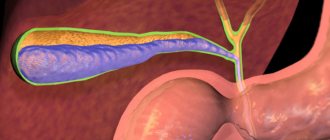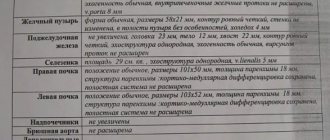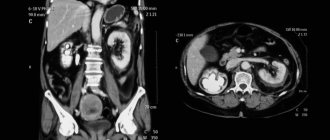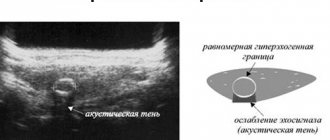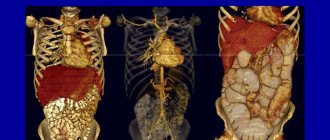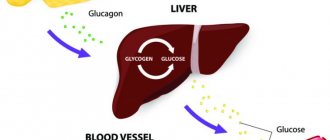3 Edition
Ultrasound of the gallbladder is performed on an empty stomach: children under 3 years old - fasting for 4 hours, from 3 to 12 years old - fasting for 6 hours; adults - fast for 8 hours, do not drink or smoke for 3 hours.
When food from the stomach enters the duodenum, the gallbladder contracts and secretes bile. Biliary dyskinesia is uncoordinated contraction/relaxation.
With hypomotor dyskinesia, heaviness in the right side, sometimes bitterness in the mouth and nausea are common; due to stagnation of bile, the liver is enlarged.
With hypermotor dyskinesia, there is often paroxysmal pain in the right hypochondrium after fatty and spicy foods, sometimes from fast walking and running.
The contractility of the gallbladder depends on the tension of the wall and the play of the sphincters. The functioning of the gallbladder can be assessed by ultrasound after a choleretic “breakfast”.
It is convenient to use Hofitol 20% as a choleretic agent: children under 10 years old - 1 ml per year of life, over 10 years old and adults - 10-20 ml. To distinguish the stomach, the medicine is washed down with water.
Before the gallbladder begins to contract, ultrasound is performed continuously, then every 8-10 minutes. The common bile duct and gallbladder volume are measured.
Volume of the gallbladder: V=D*B²*0.523, where D is the length and B is the height in the longitudinal section.
Gallbladder reaction to choleretic agent
- Type 1 - uniform contraction up to 30 minutes, relaxation at 40 minutes;
- Type 2 - contraction for up to 15 minutes, then persistent relaxation;
- Type 3 - very weak contraction, the volume remains almost unchanged or increases slowly;
- Type 4 - relaxation up to 15 minutes, reduction between 15-30 minutes, relaxation at 40 minutes;
- Type 5 - contraction up to 15 minutes, relaxation and contraction again, persistent relaxation at 40 minutes.
Types 4 and 5, where phases of contraction and relaxation alternate, can be considered as manifestations of instability of the motor function of the gallbladder.
Impaired gastric emptying can slow down the process of bile secretion, and then hypomotor biliary dyskinesia is mistakenly diagnosed.
Function of the gallbladder and bile duct sphincters
Time of maximum contraction – from taking a choleretic drug to the minimum volume of the gallbladder; normally 20-40 minutes.
Latent period - from taking the choleretic drug to the beginning of gallbladder contraction; Normally up to 5 minutes.
The primary reaction is an increase in the volume of the gallbladder during the latent period.
Duration of contraction – from the beginning of contraction to the minimum volume of the gallbladder; normally 15-30 minutes.
Ejection fraction – EF(%)=(1-Vmin/Vmax)*100%, where Vmin is the minimum and Vmax is the maximum volume; normal is 40-70%.
Common bile duct 60 minutes after exercise: the dilated duct contracts - dyskinesia with spasm of the sphincter of Oddi is likely; the duct dilated even more, pain appeared - stenosis of the sphincter of Oddi is likely.
What does a doctor find out with an ultrasound of the gallbladder?
Thanks to an ultrasound examination of the gallbladder, the doctor receives the information necessary to diagnose the disease and prescribe treatment. Ultrasound provides information:
- about the size and shape of the gallbladder;
- the condition of its walls;
- bladder contractility;
- patency of the bile ducts;
- presence or absence of stones.
All this helps the attending physician create the optimal effective treatment plan.
In the multidisciplinary clinic “Center for Endosurgery and Lithotripsy,” ultrasound of the gallbladder is performed as part of a comprehensive ultrasound examination of the abdominal organs with or without functional load. The examination is carried out using modern expert-class ultrasound machines by experienced specialists.
Make an appointment through the application or by calling +7 +7 We work every day:
- Monday—Friday: 8.00—20.00
- Saturday: 8.00–18.00
- Sunday is a day off
The nearest metro and MCC stations to the clinic:
- Highway of Enthusiasts or Perovo
- Partisan
- Enthusiast Highway
Driving directions
Problem 1
A 10-year-old girl complains of periodic abdominal pain, unrelated to food intake.
Gallbladder on an empty stomach:
The topography has not been changed. The shape is a bend in a funnel. The walls are not changed. The contents are homogeneous, there are no stones. Perivesicular tissues are not changed. Choleretic “breakfast” – Chofitol 20% 10 ml.
| Time, minutes | 0 | 15 | 25 | 35 | 40 | 50 | 60 | 70 |
| Volume, cm3 | 18 | 12 | 10 | 13 | ||||
| FV, ml | 8 | |||||||
| EF, % | -44% | |||||||
| Reduction | + | + | ||||||
| Relaxation | + | |||||||
| CBD, cm | 0,17 | 0,3 | 0,3 | 0,2 |
Time of maximum contraction - from taking a choleretic drug to the minimum volume of the gallbladder (N 20-40 minutes): 25 minutes.
Latent period - from the moment of taking the choleretic drug to the beginning of contraction of the gallbladder (N up to 5 minutes): up to 5 minutes.
The primary reaction is an increase in the volume of the gallbladder during the latent period: absent.
Duration of contraction - from the beginning of contraction to the minimum volume of the gallbladder (N 15-30 minutes): 20 minutes.
Ejection fraction – EF(%)=(1-Vmin/Vmax)*100%, where Vmin is the minimum and Vmax is the maximum volume (N 40-70%): 44%.
Conclusion: Timely emptying of the gallbladder. At the time of the study, gallbladder dysfunction was not determined.
Problem 2
An 8-year-old boy complains of abdominal cramps after eating.
Gallbladder on an empty stomach:
The topography has not been changed. Shape – S-bend. The walls are not changed. The contents are homogeneous, there are no stones. Perivesicular tissues are not changed. Choleretic “breakfast” – Chofitol 20% 8 ml. After taking the medicine, nausea and abdominal pain appeared.
| Time, minutes | 0 | 10 | 20 | 30 | 40 | 50 | 60 | 70 |
| Volume, cm3 | 36 | 21 | 18 | 27 | 33 | |||
| FV, ml | 18 | |||||||
| EF, % | -50% | |||||||
| Reduction | + | + | ||||||
| Relaxation | + | + | ||||||
| OZhP, mm | 2 | 2 | 2 | 2 | 2 |
Time of maximum contraction - from taking a choleretic drug to the minimum volume of the gallbladder (N 20-40 minutes): 20 minutes.
Latent period - from the moment of taking the choleretic drug to the beginning of contraction of the gallbladder (N up to 5 minutes): up to 5 minutes.
The primary reaction is an increase in the volume of the gallbladder during the latent period: absent.
Duration of contraction - from the beginning of contraction to the minimum volume of the gallbladder (N 15-30 minutes): 15 minutes.
Ejection fraction – EF(%)=(1-Vmin/Vmax)*100%, where Vmin is the minimum and Vmax is the maximum volume (N 40-70%): 50%.
Conclusion: Accelerated emptying of the gallbladder due to strong contraction of the muscle wall.
Problem 3
A 6-year-old boy complains of pain around the navel after eating.
Gallbladder on an empty stomach:
The topography has not been changed. The shape is a bend in a funnel. The walls are not changed. The contents are homogeneous, there are no stones. Perivesicular tissues are not changed. Choleretic “breakfast” – Chofitol 20% 6 ml.
| Time, minutes | 0 | 10 | 20 | 30 | 40 | 50 | 60 | 70 |
| Volume, cm3 | 17 | 21 | 19 | 14 | 8 | 12 | 17 | |
| FV, ml | +4 | -12 | ||||||
| EF, % | +24% | -57% | ||||||
| Reduction | + | + | + | |||||
| Relaxation | + | + | + | |||||
| CBD, cm | 0,2 | 0,3 | 0,35 | 0,3 | 0,2 | 0,2 | 0,2 |
Time of maximum contraction - from taking a choleretic drug to the minimum volume of the gallbladder (N 20-40 minutes): 40 minutes.
Latent period - from the moment of taking the choleretic drug to the beginning of contraction of the gallbladder (N up to 5 minutes): 15-20 minutes.
The primary reaction is an increase in the volume of the gallbladder during the latent period: +24%.
Duration of contraction - from the beginning of contraction to the minimum volume of the gallbladder (N 15-30 minutes): 20-25 minutes.
Ejection fraction – EF(%)=(1-Vmin/Vmax)*100%, where Vmin is the minimum and Vmax is the maximum volume (N 40-70%): 57%.
Conclusion: Timely emptying of the gallbladder with a slow start, sphincter spasm is likely.
GASTROCENTER
MOLAKA EKATERINA YURIEVNA endoscopist, gastroenterologist-hepatologist, candidate of medical sciences, head. Department of Endoscopy and Gastroenterology (work experience since 1994) see full resume
KUZNETSOV KONSTANTIN VALERIEVICH Endoscopist-surgeon, gastroenterologist, head. Department of Endosurgery, member of the European Association of Gastrointestinal Endoscopy (work experience since 1995) see full resume
KHARNAS SERGEY SAULOVICH Laparoscopic surgeon, professor, doctor of medical sciences, head of the consultative department of surgery and oncology, work experience 37 years, see full resume
MUSAEV GAZIYAV KHADISOVICH Specialist in ultrasound diagnostics, minimally invasive laparoscopic surgery, Doctor of Medical Sciences, Professor
We examine and treat patients with:
- diseases of the gallbladder - cholelithiasis (GSD), biliary dyskinesias, polyposis of the gallbladder
- liver diseases, fatty liver disease (steatosis, fatty hepatosis), we verify hepatitis of viral, toxic and autoimmune origin
- diseases of the pancreas - pancreatitis,
- benign and malignant tumors (see here)
- diseases of the esophagus GERD, reflux disease, esophagitis, Barrett's esophagus, achalasia cardia and cardiospasm, diaphragmatic hernia, etc.
- diseases of the stomach and duodenum: peptic ulcer, erosive lesions of the stomach and duodenum, all types of gastritis, polyps, stomach tumors, etc.
- intestinal diseases: IBS - irritable bowel syndrome, intestinal polyps, diarrhea and constipation, ulcerative colitis and Crohn's disease, celiac disease, SIBO - colon bacterial overgrowth syndrome, dysbiosis, etc.
We conduct full CHEK UP screening examinations to identify early tumors of the gastrointestinal tract and other localizations (in our center, in one day you can undergo gastroscopy and colonoscopy in one sleep, performed by expert doctors with European practice, followed by consultation with a gastroenterologist k.m. .n.)
CONSULTATION RECEPTION
- Clinical examination by a gastroenterologist, Ph.D. with the development of an additional examination scheme 1,750 rub.
- Clinical examination by a gastroenterologist, Ph.D. with analysis of laboratory data from third-party medical institutions – 2,000 rubles
- Clinical examination by a gastroenterologist, Ph.D. with analysis of laboratory data, drawing up a drug therapy regimen and individual diet - 3,450 rubles
- Primary consultation with a specialist doctor with European practice – 1,750 rubles
- Consultation with a laparoscopic surgeon, professor, MD. – 4.850rub
DISCOUNTS AND CONVENIENT PROMOTIONS: GASTROCENTER cooperates with major medical institutions in Russia in the field of studying Helicobacter pylori, GASTROCENTER widely practices promotions and discount programs.
STS TV channel about us: popular program about health from 06/11/17
PHOTO GALLERY PRICE LIST, PROMOTIONS AND DISCOUNTS
Advantages of GASTROCENTER
o RULE OUT TUMORS: AT THE GASTROCENTER you can undergo a complete examination (Check-up) of the gastrointestinal tract in one day, painlessly and inexpensively, to exclude the development of tumors, which rank first in prevalence in the world and in Russia. o IN YOUR SLEEP: do the examination in your sleep, which improves the quality of the examination and makes it comfortable and safe. o ALL TESTS AT ONCE: during the study we perform all tests - Helicobacter Pylori (ready in 3 minutes), histology, etc. o HIGH-PRECISION EQUIPMENT: do research on EVIS EXERA II (Japan) - ultra-precise modern equipment: with the possibility of optical and electronic zoom., NBI, HDTV. o EXPERT CLASS DOCTORS: our doctors, Ph.D., have over 20 years of experience in the largest Russian medical institutions, experience in Europe and training in Japan to identify and remove through a flexible endoscope the smallest tumors invisible in a conventional endoscope. In addition, our specialists treat patients, being at the same time gastroenterologists, hepatologists and nutritionists (European standard of gastroenterologist). o GET HELP OF A GASTROENTEROLOGIST IMMEDIATELY: AT THE GASTROCENTER you will be consulted by a doctor, candidate of medical sciences, gastoenterologist, immediately after the examination. o DO GASTROSCOPY, COLONOSCOPY, VIDEO CAPSULE ENDOSCOPY, BRONCHOSCOPY IN YOUR SLEEP IMMEDIATELY IN ONE DAY: AT THE GASTROCENTER you can do all types of endoscopic examinations and/or several examinations at once in one day: and immediately from the same specialist get advice on drug treatment and necessary further examination of your diseases. o IMMEDIATELY REMOVE POLYPS AND CARRY OUT ENDOSCOPIC OPERATIONS IN YOUR SLEEP AND WITHOUT HOSPITALIZATION simultaneously during gastroscopy or colonoscopy, bronchoscopy: in the Gastrocenter all types (see price list, list of operations) of endoscopic operations are performed through a flexible endoscope (“surgery without an incision”) by expert class specialists . o TAKE ALL TESTS IMMEDIATELY: IN THE GASTROCENTER all types of laboratory tests and ultrasound are performed. You can undergo a complete examination of the gastrointestinal tract in one day, and for smokers, check the condition of the tracheobronchial tree and lungs.
- DISCOUNTS AND CONVENIENT PROMOTIONS: GASTROCENTER cooperates with major medical institutions in Russia in the field of studying Helicobacter pylori, GASTROCENTER widely practices promotions and discount programs.
Cholelithiasis (GALLBLADDER STONES)
The formation of gallstones is caused by a disorder in the body's metabolism of bilirubin and/or cholesterol.
For what reasons do gallstones form?
Most often this is a consequence of overweight (obesity), fasting, changes in hormone metabolism in women during pregnancy, when taking contraceptives (birth control drugs), diseases of the small intestine, alcoholism, hereditary factors, hypomotor dyskinesia of the gallbladder with sediment in it or microcholelithiasis ( sand). What symptoms accompany gallstone disease? The most striking picture characteristic of cholelithiasis is biliary (bile) colic: pain in the right hypochondrium, pain in the upper abdomen, bloating, gas formation. More often, such symptoms occur in patients when eating foods rich in fat.
How does a gallstone behave?
Manifestations of gallstone disease depend on the location of the stones in the gall bladder and their size. A stone that, when the gallbladder contracts, enters the neck of the gallbladder and blocks the exit from the gallbladder causes biliary colic. Sometimes he comes back
I back into the gallbladder or passes into the cystic duct, then the common bile duct. If the stone is up to half a centimeter in size, then it can fall into the duodenum and appear in the stool. If the stone stops in the common bile duct and blocks it partially or completely, an even more dangerous complication will arise - cholangitis. In this case, inflammation of the walls of the common bile duct occurs, body temperature rises, chills, symptoms of jaundice, the patient requires emergency hospitalization.
How are gallbladder diseases diagnosed?
An ultrasound examination of the abdominal organs, gastroscopy (EGDS, esophagogastroduodenoscopy) with examination of the bulbous sections and the papilla of Vater, a biochemical study of blood and urine are performed. A patient who has been diagnosed with gallstones must undergo a scheduled consultation with a surgeon to choose the most optimal treatment tactics.
gastrocenter, digital video endoscope
At the present stage, surgery has achieved tremendous success in conducting minimally invasive, gentle and low-traumatic operations to remove the gallbladder. In our GASTROCENTER, patients with cholelithiasis are advised by laparoscopic surgeon, professor, doctor of medical sciences, laureate of the Moscow government award for achievements in the field of medicine and oncology Sergey Saulovich Kharnas
GALLBLADDER POLYPS
With a single true polyp of the gallbladder, if it does not reach 1 cm in size and is detected for the first time, the patient is often observed. If the polyp is more than 1 cm in diameter or is growing rapidly, or with multiple polyps, the patient must be consulted by a surgeon and the issue of removing the gallbladder (cholecystectomy) will be decided. At the present stage, surgery has achieved tremendous success in conducting minimally invasive, gentle and low-traumatic operations to remove the gallbladder. In our GASTROCENTER, patients with cholelithiasis are advised by laparoscopic surgeon, professor, doctor of medical sciences, laureate of the Moscow government award for achievements in the field of medicine and oncology Sergey Saulovich Kharnas
Polyps may have a cholesterol structure, while their ultrasound picture differs from that of true polyps; the tactics in the presence of such polyps are not surgical; in this case, the patient is clinically observed and treated by a gastroenterologist (see summary of specialists)
Problem 4
A 3-year-old girl complains of a tendency to constipation. It is necessary to exclude the hypomotor variant of JVP.
Gallbladder on an empty stomach: The topography is not changed. Shape – S-bend. The walls are not changed. Contents: a small amount of fine suspension, no stones. Perivesicular tissues are not changed. Choleretic “breakfast” – Chofitol 20% 3 ml.
| Time, minutes | 0 | 15 | 25 | 35 | 45 | 50 | 60 | 70 |
| Volume, cm3 | 6 | 7,5 | 5,5 | 4 | 4 | 7 | ||
| FV, ml | +1,5 | -3,5 | ||||||
| EF, % | +25% | -47% | ||||||
| Reduction | + | + | ||||||
| Relaxation | + | + | ||||||
| CBD, cm | 0,12 | 0,2 | 0,19 | 0,15 | 0,15 |
Time of maximum contraction - from taking a choleretic drug to the minimum volume of the gallbladder (N 20-40 minutes): 35 minutes.
Latent period - from the moment of taking the choleretic drug to the beginning of gallbladder contraction (N up to 5 minutes): more than 15 minutes.
The primary reaction is an increase in the volume of the gallbladder during the latent period: +25%.
Duration of contraction - from the beginning of contraction to the minimum volume of the gallbladder (N 15-30 minutes): 20 minutes.
Ejection fraction – EF(%)=(1-Vmin/Vmax)*100%, where Vmin is the minimum and Vmax is the maximum volume (N 40-70%): 47%.
Conclusion: Timely emptying of the gallbladder with a slow start. Probably a strong contraction of the wall during sphincter spasm. There was no evidence of hypomotor dyskinesia at the time of the study.
How to prepare for an ultrasound of the gallbladder?
Before an ultrasound examination of the gallbladder, it is advisable to prepare for the procedure. To do this, the patient will have to limit his diet for three days, not consuming foods that cause gas formation. In particular, the diet of a patient preparing for an ultrasound of the gallbladder should not include raw vegetables, legumes, milk and black bread. You should also not drink sugary carbonated drinks. In addition, to prevent flatulence, it is recommended to take enterosorbents. People prone to severe flatulence or suffering from constipation should take a laxative the day before the examination and perhaps even do a cleansing enema the day before.
In each specific case, there may be individual recommendations for preparation, which will be given by the attending physician. Dinner on the eve of the procedure should take place no later than 19.00 and be as light as possible. The study is performed in the first half of the day strictly on an empty stomach.
If your doctor prescribes an ultrasound of the gallbladder with a functional test, you must take breakfast with you, consisting of sour cream, heavy cream or egg yolks.
Problem 5
A 15-year-old boy complains of abdominal pain after eating, nausea and bitter taste in the mouth in the morning. On ultrasound, the size of the liver is at the upper limit of normal.
Gallbladder on an empty stomach:
The topography has not been changed. The shape is a bend in a funnel. The walls are not changed. The contents are homogeneous, there are no stones. Perivesicular tissues are not changed. Choleretic “breakfast” – Chofitol 20% 15 ml.
| Time, minutes | 0 | 10 | 20 | 30 | 40 | 50 | 60 | 85 |
| L*H, cm | 6,5*3,2 | 7,3*2,7 | 7,2*2,7 | 6,9*2,7 | 6,8*2,4 | 6,5*2,6 | 7,1*2,9 | |
| Volume, cm3 | 35 | 28 | 28 | 27 | 20 | 23 | 31 | |
| FV, ml | 15 | |||||||
| EF, % | 43% | |||||||
| Reduction | + | + | ||||||
| Relaxation | + | + | ||||||
| CBD, cm | 0,3 | 0,5 | 0,5 | 0,5 | 0,3 | 0,3 |
Time of maximum contraction - from taking a choleretic drug to the minimum volume of the gallbladder (N 20-40 minutes): 50 minutes.
Latent period - from the moment of taking the choleretic drug to the beginning of contraction of the gallbladder (N up to 5 minutes): up to 5 minutes.
The primary reaction is an increase in the volume of the gallbladder during the latent period: absent.
Duration of contraction - from the beginning of contraction to the minimum volume of the gallbladder (N 15-30 minutes): 45 minutes.
Ejection fraction – EF(%)=(1-Vmin/Vmax)*100%, where Vmin is the minimum and Vmax is the maximum volume (N 40-70%): 43%.
Conclusion: Slow emptying of the gallbladder. Probably the combined effect of hypotension of the muscle wall with sphincter spasm.
Who is the procedure indicated for?
Since ultrasound does not have a negative effect on the body, diagnosis is indicated not only for adults, but also for children. Most doctors say that it is mandatory to undergo an ultrasound for the following complaints:
- Constant feeling of nausea
- Belching with an unpleasant taste in the mouth
- Pain in the area of the gallbladder of unknown etiology
- Regular heaviness in the stomach
- Lack of appetite
- Changes in skin color
Also, experts do not recommend delaying the examination in the following cases:
- Being overweight
- Internal organ injuries
- Long-term drug treatment
- Severe poisoning
- Suspicion of the presence of stones, malignant neoplasms and congenital anomalies of the gallbladder
- Chronic pancreatitis, cholecystitis
For infants, such an examination may be prescribed due to unstable stool of unknown etiology or due to profuse vomiting of a regular nature. Older children may independently complain of disturbing symptoms. They usually indicate pressing and unpleasant pain at the location of the gallbladder.
If you suffer from the above ailments, go to a medical facility as soon as possible and get diagnosed.
Problem 6
A 15-year-old boy complains of abdominal cramps in the morning after breakfast.
Gallbladder on an empty stomach:
The topography has not been changed. The shape is a bend in a funnel. The walls are not changed. Contents: level of fine suspension, no stones. Perivesicular tissues are not changed. Choleretic “breakfast” – Chofitol 20% 15 ml. After taking the medicine, he feels discomfort in his stomach.
| Time, minutes | 0 | 10 | 20 | 30 | 40 | 50 | 60 | 70 |
| Volume, cm3 | 42 | 48 | 48 | 34 | 38 | 24 | 24 | 39 |
| FV, ml | +6 | 0 | -14 | +4 | -14 | 0 | +15 | |
| EF, % | +14% | -50% | ||||||
| Reduction | + | + | ||||||
| Relaxation | + | + | + | |||||
| CBD, cm | 0,4 | 0,5 | 0,6 | 0,5 | 0,5 | 0,5 | 0,5 | 0,4 |
Time of maximum contraction - from taking a choleretic drug to the minimum volume of the gallbladder (N 20-40 minutes): 50 minutes.
Latent period - from the moment of taking the choleretic drug to the beginning of gallbladder contraction (N up to 5 minutes): more than 20 minutes.
The primary reaction is an increase in the volume of the gallbladder during the latent period: +14%.
Duration of contraction - from the beginning of contraction to the minimum volume of the gallbladder (N 15-30 minutes): 30 minutes.
Ejection fraction – EF(%)=(1-Vmin/Vmax)*100%, where Vmin is the minimum and Vmax is the maximum volume (N 40-70%): 50%.
Conclusion: Instability of the motor function of the gallbladder: delayed start, delayed emptying, alternating phases of contraction and relaxation. A spasm of the bile duct sphincters is likely. Echo signs of dyscholia.


